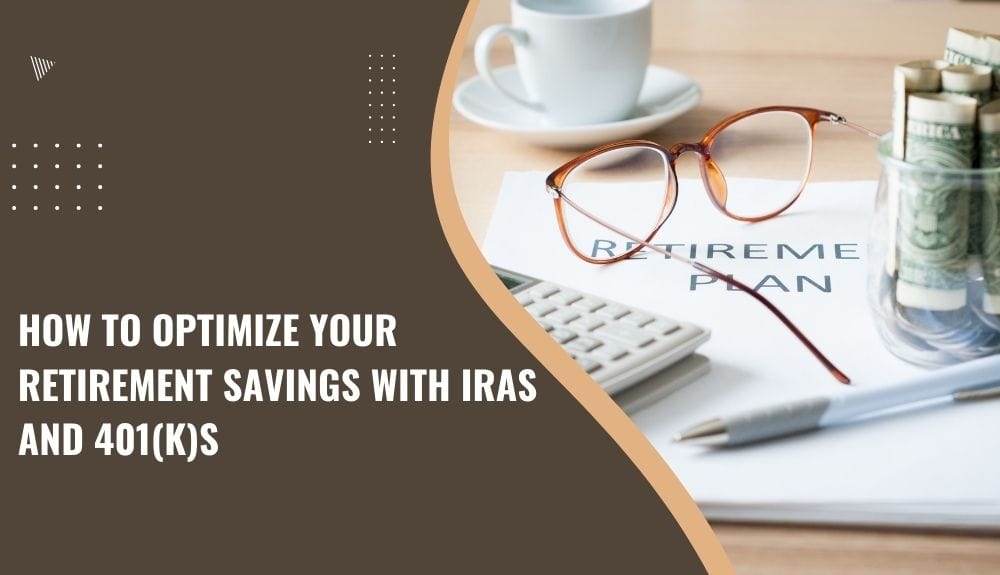Are you ready to take charge of your financial future and secure a comfortable retirement? Navigating the realm of retirement savings can seem daunting, but with the right tools and knowledge, you can optimize your IRA and 401(k) accounts to ensure a worry-free future. Imagine enjoying your golden years stress-free, knowing you’ve made smart investment decisions along the way.
In this comprehensive guide, we will delve into proven strategies for maximizing your retirement savings using IRAs and 401(k)s. From understanding contribution limits and tax benefits to exploring different investment options and growth opportunities, we’ve got you covered. Whether you’re just starting your retirement planning journey or looking to fine-tune your existing savings plan, this article will provide valuable insights to help you create a personalized strategy tailored to your financial goals and aspirations. Get ready to unlock the potential of your retirement accounts and set yourself up for financial security in the years to come.
Introduction to Maximizing Retirement Savings
When it comes to planning for retirement, maximizing your savings is crucial for securing a worry-free future. One effective way to achieve this is by leveraging Individual Retirement Accounts (IRAs) and 401(k) plans. These investment vehicles provide opportunities for tax advantages and growth potential that can significantly boost your retirement nest egg.
Why is maximizing retirement savings important? As life expectancy increases and the cost of living rises, it becomes essential to ensure that your financial resources last throughout your golden years. By carefully managing your retirement savings, you can create a sustainable income stream to support your desired lifestyle.
To make the most of your IRAs and 401(k) plans, we will explore various strategies and tips in this article. By following these guidelines, you can optimize your contributions, take advantage of tax benefits, and make informed investment decisions. Let’s dive into the effective strategies that allow you to maximize your retirement savings.
How to Max Out Your 401(k)

When it comes to building a solid retirement savings, maximizing your contributions to a 401(k) account is crucial. By taking advantage of the tax benefits and potential employer matches, you can accelerate your plans for a comfortable retirement. Here are some strategies to help you maximize your 401(k) contributions and make the most of your retirement savings:
Increase Contributions Gradually
One effective way to max out your 401(k) is to gradually increase your contributions over time. Start by contributing a small percentage of your salary and then steadily increase it each year or whenever you receive a raise. By doing so, you won’t feel the impact on your take-home pay all at once, and you’ll be well on your way to reaching the contribution limit.
Check the Default Rate
Many employers automatically enroll employees in their 401(k) plans at a default contribution rate, typically around 3%. However, this rate may not be enough to maximize your savings. Take the time to review and adjust your contribution rate to ensure you’re on track to max out your 401(k). Remember, every extra dollar you contribute now can have a significant impact on your retirement savings in the long run.
Get the Employer Matches
One of the most valuable benefits of a 401(k) plan is the employer match. Employers may offer to match a certain percentage of your contributions, typically up to a specified limit. To take full advantage of this benefit, make sure you contribute at least enough to receive the maximum match offered by your employer. Failing to do so means leaving free money on the table.
Beware of Early Withdrawal Penalties
While a 401(k) is designed for retirement savings, there may be situations where you need to access the funds before reaching retirement age. However, early withdrawals from a 401(k) account often come with hefty penalties and taxes. It’s essential to be aware of these consequences and carefully consider other options before tapping into your 401(k) prematurely.
Become an Informed Investor
Take the time to educate yourself about investment options available within your 401(k) plan. Understanding asset allocation, diversification, and risk tolerance can help you make informed investment decisions. Consider consulting with a financial advisor who can guide you in selecting the right investment strategy based on your goals and risk tolerance.
Benefits of Maxing Out Your 401(k) (100 words)
Maxing out your 401(k) contributions offers several advantages. First, it allows you to take full advantage of the tax benefits associated with this retirement account. Contributions are made on a pre-tax basis, reducing your current taxable income. Additionally, the potential for tax-free growth and compounding over time can significantly boost your retirement savings. By maxing out your 401(k), you’re giving yourself the best chance to secure a financially stable and worry-free retirement.
The Bottom Line
Maximizing your 401(k) contributions is a smart move for long-term retirement planning. By gradually increasing your contributions, taking advantage of employer matches, understanding withdrawal penalties, and becoming an informed investor, you can optimize your 401(k) and build a strong foundation for your retirement savings. Remember, every dollar you contribute now will have a significant impact on your financial security in the future.
4 Retirement Strategies You Need to Know
Retirement planning can often feel overwhelming, but with the right strategies in place, you can secure a comfortable future. Here are four essential retirement strategies that everyone should know:
1. Consider contributing to your workplace retirement account up to the employer match
One of the most effective ways to maximize your retirement savings is by contributing to your workplace retirement account, such as a 401(k) or 403(b). Take full advantage of your employer’s matching contributions, as it is essentially free money towards your retirement. By contributing up to the match, you can ensure you’re maximizing your savings potential.
2. REMINDER: YOU NEED TO CHOOSE YOUR INVESTMENTS
Once you start contributing to your retirement account, it’s crucial to choose the right investments. Research and understand the available investment options, including mutual funds, index funds, and target-date funds. Assess your risk tolerance and carefully allocate your investments accordingly to balance growth potential and risk. Regularly review and adjust your portfolio to stay aligned with your long-term goals.
3. Consider contributing the maximum amount to your health savings account (HSA)
Health savings accounts (HSAs) offer a unique opportunity to save for retirement while also covering healthcare expenses. Contributions to an HSA are tax-deductible, grow tax-free, and can be withdrawn tax-free for qualified medical expenses. Contributing the maximum amount allowed can provide additional tax advantages and build a valuable nest egg for your retirement healthcare needs.
4. Consider contributing the allowed maximum to your workplace savings plan
In addition to your employer-sponsored retirement account, explore other retirement savings options available to you. If you have the financial means, consider contributing the maximum amount allowed to your workplace savings plan. This could be a SEP-IRA, SIMPLE IRA, or another retirement plan offered by your employer. By maximizing your contributions, you can supercharge your retirement savings and take advantage of tax benefits.
Remember, these strategies are just the beginning. Each person’s financial situation is unique, and it’s crucial to seek advice from a financial advisor to create a personalized retirement plan. By implementing these strategies and staying proactive in your financial choices, you can optimize your retirement savings and enjoy a worry-free future.
Final Thoughts About How to Optimize Your Retirement Savings
As you approach your retirement years, it’s crucial to have a solid plan in place to optimize your savings. By effectively utilizing IRAs and 401(k)s, you can ensure a comfortable and worry-free future. Here are some key considerations and strategies to keep in mind.
Regularly Assess Your Financial Situation
Periodically review your financial situation and adjust your retirement savings plan accordingly. Take into account changes in income, expenses, and investment performance. Consider consulting with a financial advisor to ensure you’re on track to meet your retirement goals.
Diversify Your Investments
Diversification is a critical aspect of optimizing your retirement savings. Spread your investments across different asset classes, such as stocks, bonds, and real estate, to reduce risk and increase potential returns. Consider working with a financial advisor to develop a well-diversified portfolio that aligns with your risk tolerance and retirement goals.
Take Advantage of Catch-up Contributions
If you’re 50 years old or older, take advantage of catch-up contributions allowed in both IRAs and 401(k)s. These additional contributions can help you make up for any shortfalls in your retirement savings and accelerate your progress towards your financial goals.
Keep an Eye on Taxes
Understanding the tax implications of your retirement savings is crucial. Consider contributing to tax-advantaged accounts like Roth IRAs or Roth 401(k)s, which offer tax-free withdrawals in retirement. Additionally, explore the benefits of after-tax contributions and Roth conversions to optimize your tax situation.
Consider Health Savings Accounts (HSAs)
HSAs provide a unique opportunity to save for both healthcare expenses and retirement. Contributions to HSAs are tax-deductible, and withdrawals for qualified medical expenses are tax-free. Any unused funds can be invested and carried over year after year, ultimately providing a valuable supplemental retirement savings option.
Stay Informed and Seek Professional Advice
Stay updated on the latest retirement savings strategies, tax laws, and investment opportunities. Consider working with a qualified financial advisor who can provide personalized guidance based on your individual circumstances and goals. They can help you navigate complex retirement planning decisions and optimize your savings for the future.
The Bottom Line
Optimizing your retirement savings requires careful planning, regular assessments, and informed decision-making. By taking advantage of strategies like catch-up contributions, diversification, and tax-advantaged accounts, you can maximize your savings and enjoy a comfortable retirement. Remember, it’s never too early or too late to start optimizing your retirement savings, so begin planning today for a secure and prosperous future.
This concludes our comprehensive guide on how you can optimize your retirement savings. By implementing the strategies and tips provided throughout this article, you can take control of your financial future and enjoy a worry-free retirement. Here’s to a brighter tomorrow!
Remember, it’s always a good idea to consult with a financial advisor or retirement specialist who can provide personalized advice based on your unique circumstances and goals.
How to Get the Most Out of Your 401(k) Plan

Your 401(k) plan is a valuable tool for building a secure retirement future. By maximizing the benefits it offers, you can ensure that you’re making the most of this important retirement savings account.
The Bottom Line: Making the Most of Your 401(k) Plan
When it comes to your 401(k) plan, it’s essential to take advantage of the various features and options available to maximize its potential. Here are some key strategies to help you get the most out of your 401(k) plan:
1. Contribute the maximum to your 401(k): One of the most effective ways to optimize your 401(k) plan is by contributing the maximum allowed amount. This allows you to take full advantage of the tax benefits and potential growth opportunities. Keep track of the annual contribution limits set by the IRS to ensure you are contributing at the maximum level.
2. Consider Roth 401(k) vs. Traditional 401(k): Another important decision to make is whether to contribute to a Roth 401(k) or a traditional 401(k). With a traditional 401(k), contributions are made with pre-tax dollars, while with a Roth 401(k), contributions are made with after-tax dollars. Consider your current and future tax situation to determine which option is best for you.
3. Take advantage of employer matches: Many employers offer matching contributions to their employees’ 401(k) plans. Make sure you contribute enough to receive the full employer match, as this is essentially free money that can significantly boost your retirement savings.
4. Be mindful of investment options: Your 401(k) plan likely offers a variety of investment options. Take the time to understand these options and choose investments that align with your risk tolerance and long-term financial goals. Diversify your portfolio to minimize risk and maximize potential returns.
5. Monitor 401(k) expenses: It’s important to be aware of the fees and expenses associated with your 401(k) plan. High fees can eat into your investment returns over time. Review the expense ratios of your investment options and consider low-cost index funds or ETFs as part of your investment strategy.
6. Consider additional retirement savings options: While your 401(k) plan is a valuable retirement savings tool, it shouldn’t be your only source of savings. Explore additional options such as IRAs, health savings accounts (HSAs), and taxable brokerage accounts to further diversify your retirement savings and take advantage of potential tax benefits.
Remember, optimizing your 401(k) plan requires careful planning, regular monitoring, and adjusting your strategies as needed. Consider consulting with a financial advisor who can provide personalized advice based on your specific financial situation and goals.
By following these strategies and staying informed about your 401(k) plan, you can maximize its potential and secure a comfortable retirement.
Tips on Retirement Planning
Retirement planning is a crucial aspect of financial well-being. It involves careful consideration of various strategies to ensure a comfortable retirement. Here are some valuable tips to help you optimize your retirement savings:
1. Start Early and Be Consistent
The most effective retirement planning begins early in your career. The power of compounding allows your investments to grow over time. By starting early and consistently contributing to your retirement accounts, you can harness the benefits of long-term growth.
2. Take Advantage of Employer Matches
If your employer offers a 401(k) plan with a matching contribution, make sure to take full advantage of this benefit. It’s essentially free money that can significantly boost your retirement savings. Contribute enough to receive the full employer match to maximize this opportunity.
3. Diversify Your Investments
A well-diversified investment portfolio can help mitigate risks and maximize returns. Consider allocating your retirement savings across different asset classes, such as stocks, bonds, and real estate, to ensure a balanced and resilient portfolio.
4. Review and Adjust Your Plan Regularly
As you progress through your career and your financial situation evolves, it’s important to regularly review and adjust your retirement plan. Assess if your contributions align with your target retirement age and income goals. Seek professional advice if needed.
5. Minimize Fees and Expenses
High fees and expenses can eat into your retirement savings over time. Opt for low-cost investment options, such as index funds or exchange-traded funds (ETFs), to minimize fees and keep more of your hard-earned money working for you.
6. Consider Tax-Advantaged Accounts
Exploring tax-advantaged retirement accounts, such as Traditional IRAs or Roth IRAs, can provide additional benefits. Traditional IRAs offer tax deductions on contributions, whereas Roth IRAs provide tax-free withdrawals in retirement, subject to certain conditions. Assess which option aligns best with your future tax rates.
7. Account for Inflation
Inflation erodes the purchasing power of your savings over time. Incorporate inflation into your retirement planning calculations to ensure your savings can withstand rising costs and maintain your desired lifestyle during retirement.
8. Seek Professional Guidance
Consider consulting with a qualified financial advisor who specializes in retirement planning. They can provide personalized advice tailored to your specific financial circumstances and help you navigate complex retirement strategies.
9. Continuously Educate Yourself
Retirement planning is an ongoing process that requires staying informed about new retirement strategies, tax laws, and investment opportunities. Attend educational seminars, read books and articles, and stay updated with the latest retirement planning trends to make informed decisions.
10. Stay Disciplined and Stay the Course
Lastly, be disciplined and avoid making impulsive investment decisions. Stay the course during market fluctuations and avoid reacting emotionally to short-term market volatility. Consistency and patience are key to long-term success in retirement planning.
Incorporating these tips into your retirement planning strategy can help you optimize your savings and ensure a financially secure and comfortable retirement. Remember, it’s never too early or too late to start planning for your golden years.






